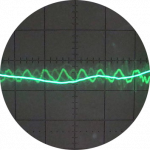And what about the pipe runs ‘outside’, i.e. in utility spaces or unheated buildings? Are they all well insulated? Regards, Toodles.
Toodles, heats his home with cold draughts and cooks food with magnets.
Posted by: @toodlesAnd what about the pipe runs ‘outside’, i.e. in utility spaces or unheated buildings? Are they all well insulated? Regards, Toodles.
Hi Toodles, don't think any outside. The plant room is all lagged. And the ASHP has a pretty heavy duty underground insulated set (I think further back in the thread someone said that should be fine).
Posted by: @iancalderbank@crimson pipes acting as radiators can be the issue accounting for temperature drop, but also flow rate.
That plastic pipe in your picture, hard to be sure but looks like it is 15mm. 15mm plastic has a much narrower bore than 15mm copper. That makes it harder for water to go through it , resulting in flow rate and balancing issues. If this pipe is serving just one radiator its fine (provided its not too long). But if its serving a group of radiators then it will be constraining the flow rate to that group , and result in what you are seeing.
what radiators does this pipe serve? do you have any other information about the pipework, particularly to the problem zone / rooms downstairs?
Unfortunately I don't have any info about the pipes. I've attached some more photos.
The one showing the small window with the pipes going to the right wall - that's the location of the utility/plant room other side of there.
I can't quite make out if that room is then the end of the downstairs run as such etc. (note the one with the spotlight in is the opposite living room, probably not a useful photo). EDIT - removed the photo of other room as confusing things with me talking about a spotlight as there's one in each room
hmm. I'm not liking what I see in picture pipes 2.
You can there's a junction between a larger pipe and a smaller. That tells me that probably the T'd off section is 15mm flow and return to a radiator in plastic. The through section is a higher size (22 or 28mm) plastic serving a group of radiators, likely there will be multiple Tees at other locations.
certainly there is a step down in size. What is crucial here is the size of the trunk that serves multiple branches.
If this is the "trunk" from which all downstairs branches are taken, and its in 22m plastic. then thats not a big enough bore pipe. The rule of thumb is that if you need to use plastic you go up a size. (22mm plastic is about the same bore, just a bit larger, than 15mm copper). So where they might have used 22mm copper, if they needed to use plastic for whatever reason (push through of joists looks like the reason here) then it should've been in 28mm plastic. There is detailed maths too but I won't bore you with that at this point.
so the question is, is the trunk 22 or 28?
If 22, it will be constraining the flow rate and resulting in the temperature drop and the impossible-to-balance situation that you have, where upstairs is wound back to almost closed and downstairs is fully open. This pipe is itself acting like a partially closed lockshield on all the flow to the rads that branch off it.
My octopus signup link https://share.octopus.energy/ebony-deer-230
210m2 house, Samsung 16kw Gen6 ASHP Self installed: Single circulation loop , PWM modulating pump.
My public ASHP stats: https://heatpumpmonitor.org/system/view?id=45
11.9kWp of PV
41kWh of Battery storage (3x Powerwall 2)
2x BEVs
Posted by: @iancalderbankhmm. I'm not liking what I see in picture pipes 2.
-- Attachment is not available --
You can there's a junction between a larger pipe and a smaller. That tells me that probably the T'd off section is 15mm flow and return to a radiator in plastic. The through section is a higher size (22 or 28mm) plastic serving a group of radiators, likely there will be multiple Tees at other locations.
certainly there is a step down in size. What is crucial here is the size of the trunk that serves multiple branches.
If this is the "trunk" from which all downstairs branches are taken, and its in 22m plastic. then thats not a big enough bore pipe. The rule of thumb is that if you need to use plastic you go up a size. (22mm plastic is about the same bore, just a bit larger, than 15mm copper). So where they might have used 22mm copper, if they needed to use plastic for whatever reason (push through of joists looks like the reason here) then it should've been in 28mm plastic. There is detailed maths too but I won't bore you with that at this point.
so the question is, is the trunk 22 or 28?
If 22, it will be constraining the flow rate and resulting in the temperature drop and the impossible-to-balance situation that you have, where upstairs is wound back to almost closed and downstairs is fully open. This pipe is itself acting like a partially closed lockshield on all the flow to the rads that branch off it.
Thanks Ian, I'll ask this with the plumbers.
I think upstairs looks to be running of this also, as I know that's approx where a rad is above this room - it can be seen in the right side of where you're highlighting:
So all in all I see:
Top right of LLH versus pipe in plant room leading to heating zone: 1C drop
Total drops with drop from zone pipe to rad + above drop
Living 2:
4.3C drop (3.3C drop from zone pipe to rad + 1C drop from LLH to zone pipe)
Living 1:
3.6C drop (2.6C drop from zone pipe to rad + 1C drop from LLH to zone pipe)
Upstairs (landing rad):
2C drop (1C drop from zone pipe to rad + 1C from from LLH to zone pipe)
Going to be very hard to balance a system that sees such a different rate.
@iancalderbank - builder believes it's a standard 22mm flow and return into a 15mm drop for the rads. But is confirming with the plumbers
@crimson you could try increasing the pump power on the secondary side, that will increase head and flow rate thus increase your chances of getting a sufficient flow on the downstairs loop that you may then be able to balance against upstairs. BUT given you have an LLH, this will now mean relative flow rates primary and secondary have just changed you'll increase the likelihood of temperature distortion on the LLH. possible catch-22.
you do need to know what pipe size those trunks are. If they are 22mm plastic serving multiple rads, I'm afraid you are going to have to get on the plumbers case for them to be upsized. Is there anything written in your specifications / plans from the architect / builder etc?
If you go down the "single loop route" as has been advocated, i.e. remove the LLH, remove those tiny bore zone valves and replace with nice fat bore 3 way diverter, then with only one pump and only one loop you can have it push as hard as you like without having to worry about LLH primary/secondary balance.
My octopus signup link https://share.octopus.energy/ebony-deer-230
210m2 house, Samsung 16kw Gen6 ASHP Self installed: Single circulation loop , PWM modulating pump.
My public ASHP stats: https://heatpumpmonitor.org/system/view?id=45
11.9kWp of PV
41kWh of Battery storage (3x Powerwall 2)
2x BEVs
Posted by: @crimson@iancalderbank - builder believes it's a standard 22mm flow and return into a 15mm drop for the rads. But is confirming with the plumbers
oh dear oh dear. 22mm plastic is not a big enough pipe for a distribution trunk for a floor's worth of radiators in a system at ASHP flow rates. if it was in 22mm copper you might have been ok.
My octopus signup link https://share.octopus.energy/ebony-deer-230
210m2 house, Samsung 16kw Gen6 ASHP Self installed: Single circulation loop , PWM modulating pump.
My public ASHP stats: https://heatpumpmonitor.org/system/view?id=45
11.9kWp of PV
41kWh of Battery storage (3x Powerwall 2)
2x BEVs
Thanks @iancalderbank - waiting for the plumber to confirm the sizing as that was just the builder's guess
Other photos seem to show a size diff that would indicate 28mm main or more, then 22mm, then 15mm copper at the end. The 22mm branches seem to be for a single rad looking through them (I won't bloat this thread with endless photos of ceilings lol).
I did wonder if they were lagged and one glimpse in a photo shows the appear to be later on in the project.
I do wonder though why the downstairs zone is getting that drop
@crimson just a sanity check. have you swapped your probes around to check that the temp differences seen are not due to calibration variation.
My octopus signup link https://share.octopus.energy/ebony-deer-230
210m2 house, Samsung 16kw Gen6 ASHP Self installed: Single circulation loop , PWM modulating pump.
My public ASHP stats: https://heatpumpmonitor.org/system/view?id=45
11.9kWp of PV
41kWh of Battery storage (3x Powerwall 2)
2x BEVs
Hi @iancalderbank ,
Swapped over probes looked like a similar diff initially, but now since running speed 3 on secondary pump these temps seem to have evened out whilst ASHP is off, will see next time spot a cycle if temp diff. Will see how temps are in morning, I tend to find with speed 3 the temps drop a bit, but that was before using lock shields upstairs over TRVs. Which I’ll give another round on reducing those down upstairs. Living rooms seemed around 19.5C, hit 20C in evening but I think that’s simply from us being in there adding some thermal uplift lol.
Builder got back to me and said it is 22 to 15 pipes, seems odd as some photos seem to indicate a greater diff than that.
He said that shouldn’t affect things as a small zone pipe work wise, not sure what’s considered small there, guess 5 downstairs rads is the reference point for that.
- 26 Forums
- 2,364 Topics
- 53.6 K Posts
- 157 Online
- 6,029 Members
Join Us!
Worth Watching
Latest Posts
-

How long will your energy contract last?
Some heat pump tariffs don’t run as long as a heat pu...
By Toodles , 2 hours ago
-

@morgan They are unsupervised these days, can’t get the...
By Toodles , 2 hours ago
-
-
RE: Octopus Cosy Heat Pump Owners & Discussion Thread
@kevh it's worth remembering that many lsvs only actual...
By JamesPa , 24 hours ago
-

RE: Setback savings - fact or fiction?
Exactly. We only need to compare conditions, to decide ...
By cathodeRay , 1 day ago
-
RE: Balancing financial efficiency and comfort using the Octopus Cosy tariff
I found because I have very low heat loss I can set bac...
By RadWhisperer , 1 day ago
-
RE: Need Help Optimising My Rushed ECO4 Install: 12kW Bosch Heat Pump
Welcome @mickamills We too have an oversized 12kW Sa...
By Old_Scientist , 2 days ago
-
RE: My Powerwall 3 Consumes 3-4 kWh/Day in Self-Consumption: Is This Normal?
@caron I can confirm that the power usage of the PW3 is...
By Old_Scientist , 2 days ago
-
RE: Speedcomfort radiator fans
Thats true, but having tried (and succeeded) in constru...
By JamesPa , 2 days ago
-
RE: Solis S6-EH1P8K-L-PLUS – Why I Chose It and What I’ve Learned So Far
@bash brilliant, thanks for the feedback
By energy9165 , 2 days ago
-

RE: Heat Pump Heats the House… But It’s Not Cosy. Emitter Changes or System Tweak?
@alastair There I was, feeling grumpy, he said “Cheer u...
By Toodles , 2 days ago
-
RE: Grant Aerona: Is there a setting to keep the 2-port valve open during pump blockade
Depends on OAT. Mine cycles at OAT>10 and of course...
By JamesPa , 2 days ago
-
RE: New Fogstar 15.5kWh upright solution
@transparent My conclusion is as you have noted, tha...
By Bash , 2 days ago
-
RE: Mitsubishi Ecodan R290 10kW performance
And to you too. Wishing you a very enjoyable festive s...
By Sheriff Fatman , 2 days ago
-

RE: External pipework insulation
They do? But that isn't apparent from the photos we'r...
By Transparent , 2 days ago
-

RE: Say hello and introduce yourself
@velcro welcome to the forums. Please feel free start a...
By Mars , 3 days ago
-
Daikin EDLA11D3V3 DHW Settings
I have a newly installed EDLA11D3V3 which I'm still get...
By Velcro , 3 days ago
-
RE: Midea ASHP – how to set weather compensation
@curlykatie did you get sorted with this?
By MickaMills , 3 days ago
-
RE: MyVaillant Connect Regular Disconnect
Thanks. Yes, if the time is consistently 11pm every nig...
By buckwem , 4 days ago










